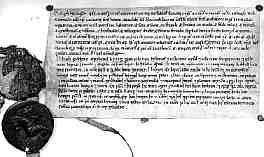Script Type : minuscule
Date : This is a late example from the 12th century.
Location : This example is from England.
Function : Book hand or document hand


























Distinctive letters : This script is not so much a true insular minuscule as a protogothic book hand with some specific features of insular minuscule. While it is a document, the use of a style more akin to book hand than that of the English chancery has caused several authors to suggest that it was produced in a monastic scriptorium and ratified by seal in the chancery.
Certain letters of the Old English text are exactly equivalent to those in the protogothic Latin part of the document. The letters a, e and s, for example, do not have a distinctively insular form and letters like m and n are angular with feet. There are two forms of d. The letters g, f and r have forms that are distinctive to insular minuscule. The letters j, v and z do not appear, but the letters k, w and y, rare in Latin, appear in the English text. Note that while i is not dotted, y is. The specifically English letters derived from the runic alphabet, notably two forms of th (edh and thorn) and one of w (wen), all appear.
The characteristic ligatures of insular minuscule are not present, except for the dipthong æ as in
![]() .
.
There are few abbreviations in the English text, with the main exception of the nomina sacra and the and derived from Tironian notes. The similarities and differences with the Latin script can be seen by looking at the sections with similar Old English words.
Latin
English
Latin
English
Without being any kind of expert on Old English, it is possible to pull out a few recognisable phrases. Pass the cursor slowly along the lines of text to find some. To examine the document in more detail, proceed to the paleography exercises.
Paleography
exercises using Flash ![]()
Requires at least the Flash 5 plugin
If you are looking at this page without frames, there is more information about medieval writing to be found by going to the home page (framed) or the site map (no frames).